Recent Advances in Chemistry and Bioactivities of Secondary Metabolites from the Genus Acremonium
Abstract
1. Introduction
2. Secondary Metabolites
2.1. Terpenoids
2.1.1. Sesquiterpenoids
2.1.2. Diterpenes
2.1.3. Meroterpenoids
2.2. Peptides
2.2.1. Linear Peptides
2.2.2. Cyclic Peptides
2.3. Polyketides
2.4. Steroids, Amides, or Alkaloids
2.4.1. Steroids
2.4.2. Amides
2.4.3. Alkaloids
3. Comprehensive Overview and Conclusions
Supplementary Materials
Author Contributions
Funding
Conflicts of Interest
References
- Atanasov, A.G.; Zotchev, S.B.; Dirsch, V.M.; Orhan, I.E.; Banach, M.; Rollinger, J.M.; Barreca, D.; Weckwerth, W.; Bauer, R.; Bayer, E.A.; et al. Natural products in drug discovery: Advances and opportunities. Nat. Rev. Drug Discov. 2021, 20, 200–216. [Google Scholar] [CrossRef] [PubMed]
- Newman, D.J.; Cragg, G.M. Natural products as sources of new drugs over the nearly four decades from 01/1981 to 09/2019. J. Nat. Prod. 2020, 83, 770–803. [Google Scholar] [CrossRef] [PubMed]
- Knowles, S.L.; Raja, H.A.; Roberts, C.D.; Oberlies, N.H. Fungal-fungal co-culture: A primer for generating chemical diversity. Nat. Prod. Rep. 2022, 39, 1557–1573. [Google Scholar] [CrossRef] [PubMed]
- Keller, N.P. Fungal secondary metabolism: Regulation, function and drug discovery. Nat. Rev. Microbiol. 2019, 17, 167–180. [Google Scholar] [CrossRef] [PubMed]
- Giraldo, A.; Gene, J.; Cano, J.; de Hoog, S.; Decock, C.; Guarro, J. Acremonium with catenate elongate conidia: Phylogeny of Acremonium fusidioides and related species. Mycologia 2014, 106, 328–338. [Google Scholar] [CrossRef] [PubMed]
- Yao, L.; Xu, L.X.; Xue, J.H.; Wei, X.Y.; Wu, P. Antibacterial activity and metabolites of an Acremonium fungus. J. Trop. Subtrop. Botany 2012, 20, 192–196. [Google Scholar]
- Wu, P.; Yao, L.; Xu, L.; Xue, J.; Wei, X.Y. Bisacremines A–D, dimeric acremines produced by a soil–derived Acremonium persicinum strain. J. Nat. Prod. 2015, 78, 2161–2166. [Google Scholar] [CrossRef]
- Peng, X.P.; Li, G.; Ji, L.X.; Li, Y.X.; Lou, H.X. Acrepyrone A, a new γ–pyrone derivative from an endophytic fungus, Acremonium citrinum SS–g13. Nat. Prod. Res. 2020, 34, 1091–1096. [Google Scholar] [CrossRef]
- Suciati; Fraser, J.A.; Lambert, L.K.; Pierens, G.K.; Bernhardt, P.V.; Garson, M.J. Secondary metabolites of the sponge–derived fungus Acremonium persicinum. J. Nat. Prod. 2013, 76, 1432–1440. [Google Scholar] [CrossRef]
- Luo, X.W.; Cai, G.D.; Guo, Y.F.; Gao, C.H.; Huang, W.F.; Zhang, Z.H.; Lu, H.M.; Liu, K.; Chen, J.H.; Xiong, X.F.; et al. Exploring marine–derived ascochlorins as novel human dihydroorotate dehydrogenase inhibitors for treatment of triple–negative breast cancer. J. Med. Chem. 2021, 64, 13918–13932. [Google Scholar] [CrossRef]
- Abdel–Lateff, A.; König, G.M.; Fisch, K.M.; Höller, U.; Jones, P.G.; Wright, A.D. New antioxidant hydroquinone derivatives from the algicolous marine fungus Acremonium sp. J. Nat. Prod. 2002, 65, 1605–1611. [Google Scholar] [CrossRef]
- Zhuravleva, O.I.; Antonov, A.S.; Oleinikova, G.K.; Khudyakova, Y.V.; Popov, R.S.; Denisenko, V.A.; Pislyagin, E.A.; Chingizova, E.A.; Afiyatullov, S.S. Virescenosides from the holothurian–associated fungus Acremonium striatisporum Kmm 4401. Mar. Drugs 2019, 17, 616. [Google Scholar] [CrossRef] [PubMed]
- Wang, Y.Z.; Guo, F.; Zhou, Y.G. Survey of Acremonium species from China with three new records. Mycosystema 2002, 21, 192–195. [Google Scholar]
- Tian, J.; Lai, D.; Zhou, L. Secondary metabolites from Acremonium fungi: Diverse structures and bioactivities. Mini-Rev. Med. Chem. 2017, 17, 603–632. [Google Scholar] [CrossRef] [PubMed]
- Cheng, Z.; Zhao, J.; Liu, D.; Proksch, P.; Zhao, Z.; Lin, W. Eremophilane–type sesquiterpenoids from an Acremonium sp. fungus isolated from deep–sea sediments. J. Nat. Prod. 2016, 79, 1035–1047. [Google Scholar] [CrossRef] [PubMed]
- Pulat, S.; Hillman, P.F.; Kim, S.; Asolkar, R.N.; Kim, H.; Zhou, R.; Tas, I.; Gamage, C.D.B.; Varli, M.; Park, S.Y.; et al. Marinobazzanan, a bazzanane-type sesquiterpenoid, suppresses the cell motility and tumorigenesis in cancer cells. Mar. Drugs 2023, 21, 153. [Google Scholar] [CrossRef] [PubMed]
- Kim, H.J.; Li, X.J.; Kim, D.C.; Kim, T.K.; Sohn, J.H.; Kwon, H.; Lee, D.; Kim, Y.C.; Yim, J.H.; Oh, H. PTP1B inhibitory secondary metabolites from an antarctic fungal strain Acremonium sp. SF-7394. Molecules 2021, 26, 5505. [Google Scholar] [CrossRef] [PubMed]
- Bunyapaiboonsri, T.; Yoiprommarat, S.; Lapanun, S.; Balram, U.; Chanthaket, R.; Klaysuban, A.; Suetrong, S. Trichothecenes from the fungus Acremonium crotocinigenum BCC 20012. Phytochem. Lett. 2016, 18, 39–43. [Google Scholar] [CrossRef]
- Araki, Y.; Awakawa, T.; Matsuzaki, M.; Cho, R.; Matsuda, Y.; Hoshino, S.; Shinohara, Y.; Yamamoto, M.; Kido, Y.; Inaoka, D.K.; et al. Complete biosynthetic pathways of ascofuranone and ascochlorin in Acremonium egyptiacum. Proc. Natl. Acad. Sci. USA 2019, 116, 8269–8274. [Google Scholar] [CrossRef]
- Miyazaki, Y.; Inaoka, D.K.; Shiba, T.; Saimoto, H.; Sakura, T.; Amalia, E.; Kido, Y.; Sakai, C.; Nakamura, M.; Moore, A.L.; et al. Selective cytotoxicity of dihydroorotate dehydrogenase inhibitors to human cancer cells under hypoxia and nutrient-deprived conditions. Front. Pharmacol. 2018, 9, 997. [Google Scholar] [CrossRef]
- Zhang, Z.H.; Zhang, Y.D.; Yang, C.J.; Wang, Q.Y.; Wang, H.; Zhang, Y.T.; Deng, W.B.; Nie, Y.C.; Liu, Y.H.; Luo, X.W.; et al. Antitumor effects of 3-bromoascochlorin on small cell lung cancer via inhibiting MAPK pathway. Cell Biol. Int. 2021, 45, 2380–2390. [Google Scholar] [CrossRef]
- Guo, L.; Luo, X.W.; Yang, P.; Zhang, Y.T.; Huang, J.L.; Wang, H.; Guo, Y.F.; Huang, W.F.; Chen, Z.Q.; Wang, S.S.; et al. Ilicicolin a exerts antitumor effect in castration-resistant prostate cancer via suppressing EZH2 signaling pathway. Front. Pharmacol. 2021, 12, 723729. [Google Scholar] [CrossRef] [PubMed]
- Enkai, S.; Kouguchi, H.; Inaoka, D.K.; Shiba, T.; Hidaka, M.; Matsuyama, H.; Sakura, T.; Yagi, K.; Kita, K. Killing two birds with one stone: Discovery of dual inhibitors of oxygen and fumarate respiration in zoonotic parasite, echinococcus multilocularis. Antimicrob. Agents Chemother. 2023, 67, e01428-22. [Google Scholar] [CrossRef] [PubMed]
- Chen, X.D.; Yang, S.Q.; Li, X.M.; Wang, B.G.; Li, X. Antibacterial polyketides and ascochlorins from deep-sea cold-seep-derived fungus Furcasterigmium furcatum (syn. Acremonium furcatum). Deep. Sea Res. Part I 2023, 199, 104114. [Google Scholar] [CrossRef]
- Hao, X.M.; Li, S.S.; Ni, J.; Wang, G.Y.; Li, F.; Li, Q.; Chen, S.Z.; Shu, J.C.; Gan, M.L. Acremopeptaibols A–F, 16-residue peptaibols from the sponge-derived Acremonium sp. IMB18–086 cultivated with heat–killed Pseudomonas aeruginosa. J. Nat. Prod. 2021, 84, 2990–3000. [Google Scholar] [CrossRef] [PubMed]
- Alves, A.J.S.; Pereira, J.A.; Dethoup, T.; Cravo, S.; Mistry, S.; Silva, A.M.S.; Pinto, M.M.M.; Kijjoa, A. A new meroterpene, a new benzofuran derivative and other constituents from cultures of the marine sponge–associated fungus Acremonium persicinum KUFA 1007 and their anticholinesterase activities. Mar. Drugs 2019, 17, 379. [Google Scholar] [CrossRef] [PubMed]
- Ruiz-Jimenez, A.L.; Ruiz-Sánchez, E.; Heredia, G.; Tapia-Tussell, R.; González-Coloma, A.; Peraza-Jiménez, K.; Moo-Koh, F.A.; Medina-Baizabal, I.L.; Hernandez-Romero, Y.; Mena-Rejón, G.J.; et al. Identification of insect-deterrent metabolites from Acremonium masseei strain CICY026, a saprophytic fungus from a sinkhole in yucatán. Microorganisms 2019, 7, 712. [Google Scholar] [CrossRef] [PubMed]
- Tian, C.; Gao, H.; Peng, X.P.; Li, G.; Lou, H.X. Fusidic acid derivatives from the endophytic fungus Acremonium pilosum F47. J. Asian Nat. Prod. Res. 2021, 23, 1148–1155. [Google Scholar] [CrossRef]
- Iijima, M.; Amemiya, M.; Sawa, R.; Kubota, Y.; Kunisada, T.; Momose, I.; Kawadal, M.; Shibasaki, M. Acremopeptin, a new peptaibol from Acremonium sp. PF1450. J. Antibiot. 2017, 70, 791–794. [Google Scholar] [CrossRef]
- Wang, C.; Wu, P.; Yao, L.; Xue, J.H.; Xu, L.X.; Li, H.X.; Deng, W.Q.; Wei, X.Y. Acremotins A–D, peptaibiotics produced by the soil-derived fungus Acremonium persicinum SC0105. J. Antibiot. 2018, 71, 927–938. [Google Scholar] [CrossRef]
- Wu, G.; Dentinger, B.T.M.; Nielson, J.R.; Peterson, R.T.; Winter, J.M. Emerimicins V–X, 15-residue peptaibols discovered from an Acremonium sp. through integrated genomic and chemical approaches. J. Nat. Prod. 2021, 84, 1113–1126. [Google Scholar] [CrossRef] [PubMed]
- Hsiao, G.; Wang, S.W.; Chiang, Y.R.; Chi, W.C.; Kuo, Y.H.; Do Anh, P.; Chen, C.Y.; Lee, T.H. Anti-inflammatory effects of peptides from a marine algicolous fungus Acremonium sp. NTU492 in BV-2 microglial cells. J. Food Drug Anal. 2020, 28, 89–97. [Google Scholar] [CrossRef]
- Luo, M.H.; Zang, R.C.; Wang, X.; Chen, Z.M.; Song, X.X.; Ju, J.H.; Huang, H.B. Natural hydroxamate-containing siderophore acremonpeptides A–D and an aluminum complex of acremonpeptide D from the marine–derived Acremonium persicinum SCSIO 115. J. Nat. Prod. 2019, 82, 2594–2600. [Google Scholar] [CrossRef] [PubMed]
- Kim, S.; Lee, C.W.; Park, S.Y.; Asolkar, R.N.; Kim, H.; Kim, G.J.; Oh, S.J.; Kim, Y.; Lee, E.Y.; Oh, D.C.; et al. Acremonamide, a cyclic pentadepsipeptide with wound-healing properties isolated from a marine-derived fungus of the genus Acremonium. J. Nat. Prod. 2021, 84, 2249–2255. [Google Scholar] [CrossRef] [PubMed]
- Li, Y.X.; Li, Z.Y. Cyclopeptide derivatives from the sponge-derived fungus Acremonium persicinum F10. Mar. Drugs 2021, 19, 537. [Google Scholar] [CrossRef] [PubMed]
- Xu, Q.; Zhang, M.M.; Yan, S.Z.; Cao, L.F.; Li, Q.; Lin, J.; Chen, S.L. Two dibenzoquinones from the fungus Acremonium cavaraeanum. Nat. Prod. Commun. 2017, 12, 1765–1768. [Google Scholar] [CrossRef]
- Wang, X.Y.; Ye, X.S.; Gao, S.; Liu, J.X.; Tian, W.J.; Wang, G.H.; Chen, H.F.; Lin, T. Cytotoxic compound triacremoniate from marine fungus Acremonium citrinum. MMF4. Fitoterapia 2020, 147, 104766. [Google Scholar] [CrossRef]
- Wang, Z.R.; Yang, H.X.; Peng, X.P.; Li, G.; Lou, H.X. Induced production of zinniol analogues by co-cultivation of two endophytic fungi in the same ecological niche. Phytochem. Lett. 2020, 35, 206–210. [Google Scholar] [CrossRef]
- Yuan, X.L.; Wang, X.F.; Xu, K.; Li, W.; Chen, D.; Zhang, P. Characterization of a new insecticidal anthraquinone derivative from an endophyte of Acremonium vitellinum against Helicoverpa armigera. J. Agric. Food Chem. 2020, 68, 11480–11487. [Google Scholar] [CrossRef]
- Lu, H.M.; Tan, Y.H.; Zhang, Y.T.; Li, Z.C.; Luo, X.W.; Chen, J.Y.; Gao, C.H.; Liu, Y.H. Osteoclastogenesis inhibitory phenolic derivatives produced by the Beibu Gulf coral-associated fungus Acremonium sclerotigenum GXIMD 02501. Fitoterapia 2022, 159, 105201. [Google Scholar] [CrossRef]
- An, X.; Feng, B.M.; Chen, G.; Chen, S.F.; Wang, H.F.; Pei, Y.H. Isolation and identification of two new compounds from marine-derived fungus Acremonium fusidioides RZ01. Chin. J. Nat. Med. 2016, 14, 934–938. [Google Scholar] [CrossRef]
- Elfita, E.; Munawar, M.; Muharni, M.; Pratiwi, G.; Rahmadania, R. A new benzoyl compound isolated from the endophytic fungi of kandis gajah (Garcinia griffithii) and asam kandis (Garcinia cowa). Makara J. Sci. 2016, 20, 167–172. [Google Scholar] [CrossRef]
- An, C.L.; Ma, Q.Y.; Xie, Q.Y.; Yang, L.; Yuan, J.Z.; Dai, H.F.; Zhao, Y.X. Chemical constituents of the marine-derived fungus Acremonium sp. AN-13. J. Asian Nat. Prod. Res. 2023. [Google Scholar] [CrossRef]
- Peng, X.P.; Li, G.; Wang, L.M.; Wang, Q.; Wang, C.; Ji, L.X.; Cao, C.X.; Lin, G.F.; Jiang, Z.Y.; He, Z.Q.; et al. Structurally various sorbicillinoids from an endophytic fungus Acremonium citrinum SS-g13. Front. Microbiol. 2022, 13, 800626. [Google Scholar] [CrossRef] [PubMed]
- Duan, C.B.; Wang, S.Y.; Huo, R.Y.; Li, E.W.; Wang, M.; Ren, J.W.; Pan, Y.Y.; Liu, L.; Liu, G. Sorbicillinoid derivatives with the radical scavenging activities from the marine-derived fungus Acremonium chrysogenum C10. J. Fungi 2022, 8, 530. [Google Scholar] [CrossRef] [PubMed]
- Li, Y.H.; Wu, J.; Xie, M.M.; Zhang, Y.; Yang, X.W. Chemical constituents of the deep-sea-derived Acremonium alternatum and their chemotaxonomic significance. Biochem. Syst. Ecol. 2022, 103, 104443. [Google Scholar] [CrossRef]
- Feng, Y.P.; Wang, H.K.; Wu, J.L.; Shao, P.; Zhou, W.L.; Lai, Q.L.; Lin, H.W.; Naman, C.B.; Wang, T.T.; He, S. Acremocholone, an anti-vibrio steroid from the marine mesophotic zone ciocalypta sponge-associated fungus Acremonium sp. NBUF150. Chem. Biodivers. 2022, 19, e202200028. [Google Scholar] [CrossRef] [PubMed]
- Lin, P.; Tian, C.; Peng, X.P.; Lou, H.X.; Li, G. Metabolic profiling for the discovery of two rare fusidane-type heterodimers from the fungal endophyte Acremonium pilosum F47. Steroids 2023, 192, 109188. [Google Scholar] [CrossRef] [PubMed]
- Franceschy, C.; Espinoza, C.; Padron, J.M.; Landa-Cadena, G.; Norte, M.; Fernandez, J.J.; Shnyreva, A.; Trigos, A. Antiproliferative potential of 3β,5α,6β,7α-tetrahydroxyergosta-8(14), 22-diene produced by Acremonium persicinum isolated from an alkaline crater lake in Puebla, Mexico. Nat. Prod. Res. 2021, 35, 2895–2898. [Google Scholar] [CrossRef]
- Chen, D.; Zhang, P.; Liu, T.; Wang, X.F.; Li, Z.X.; Li, W.; Wang, F.L. Insecticidal activities of chloramphenicol derivatives isolated from a marine alga-derived endophytic fungus, Acremonium vitellinum, against the cotton bollworm, Helicoverpa armigera (Hübner) (Lepidoptera: Noctuidae). Molecules 2018, 23, 2995. [Google Scholar] [CrossRef]
- Alfatah, M.; Wong, J.H.; Nge, C.E.N.; Kong, K.W.; Low, K.N.; Leong, C.Y.; Crasta, S.; Munusamy, M.; Chang, A.M.L.; Hoon, S.; et al. Hypoculoside, a sphingoid base-like compound from Acremonium disrupts the membrane integrity of yeast cells. Sci. Rep. 2019, 9, 710. [Google Scholar] [CrossRef]
- Huang, B.Y.; Lu, H.M.; Zhang, Y.T.; Gan, X.; Wang, X.N.; Liu, Y.H.; Luo, X.W. Bioactive alkaloids from the Beibu Gulf coral-associated fungus Acremonium sclerotigenum GXIMD 02501. Rec. Nat. Prod. 2023, 17, 165–169. [Google Scholar]
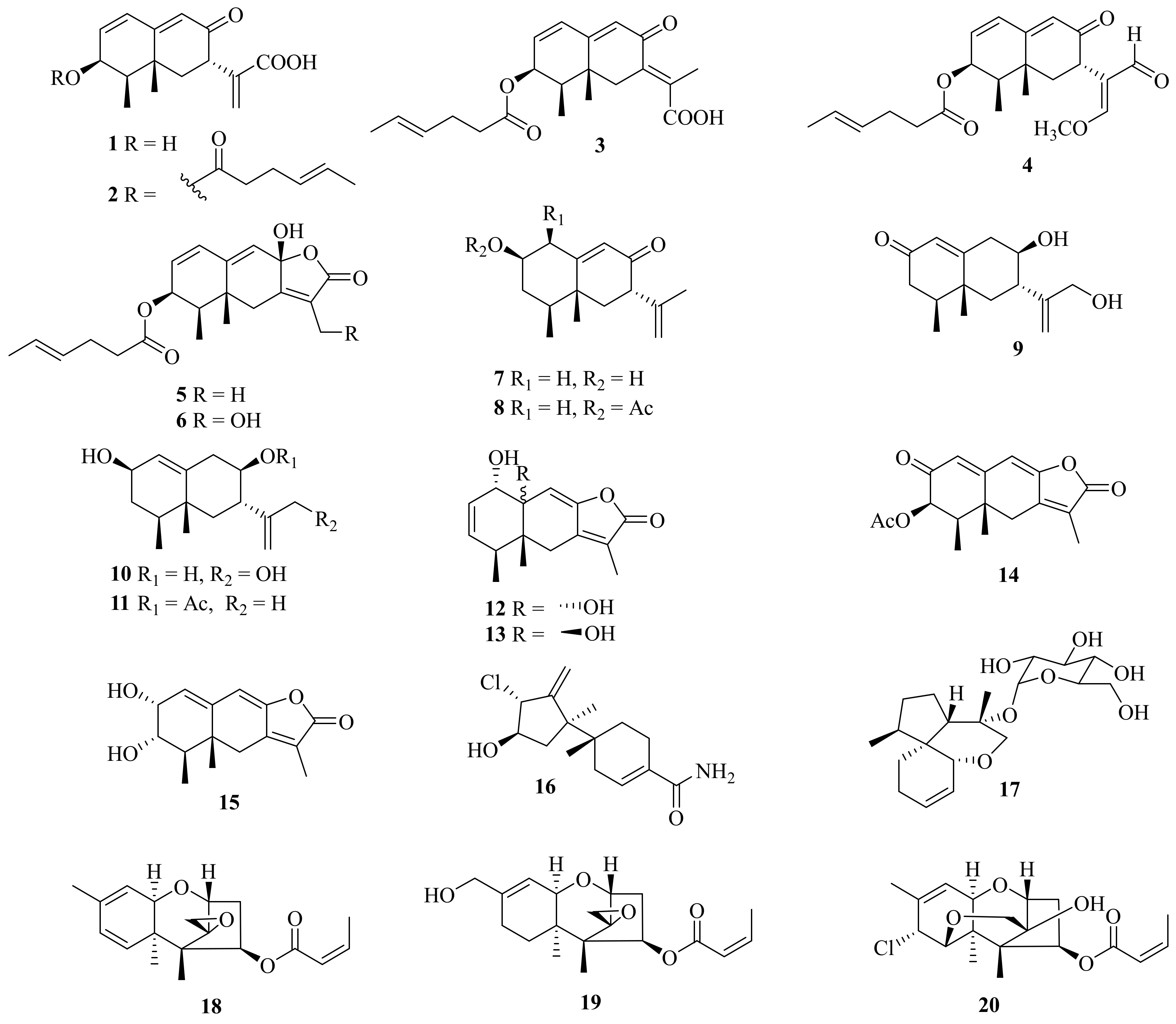
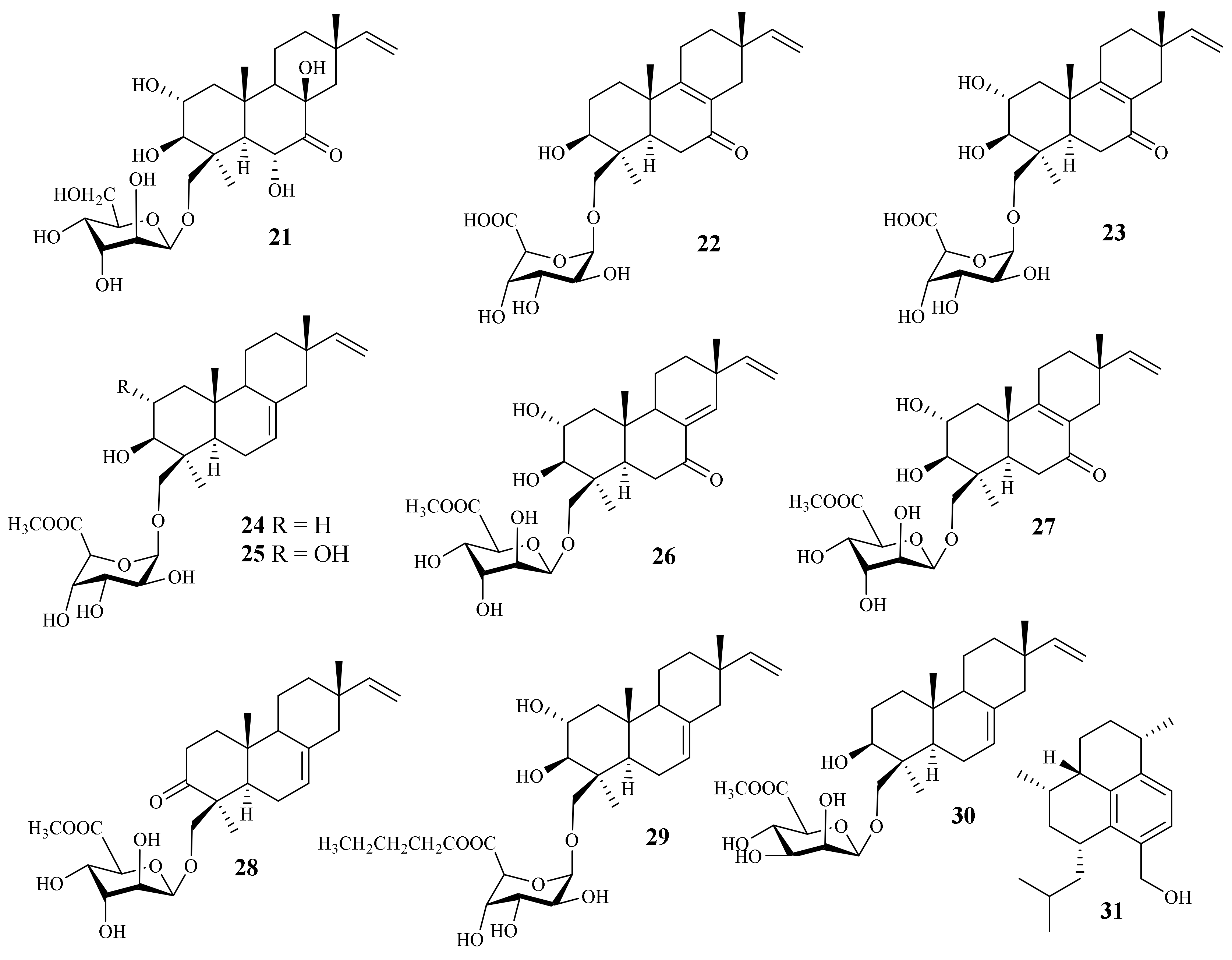
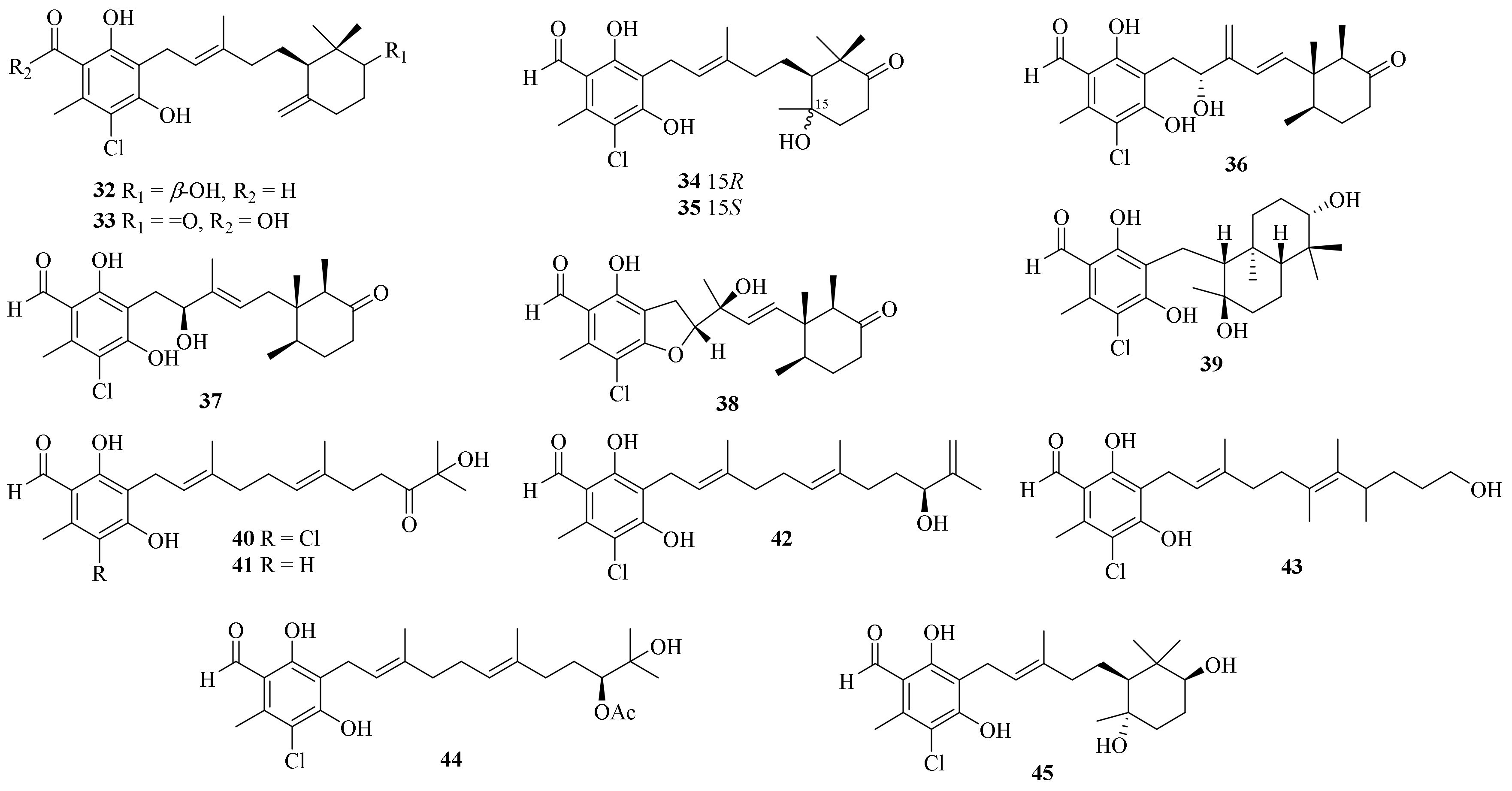

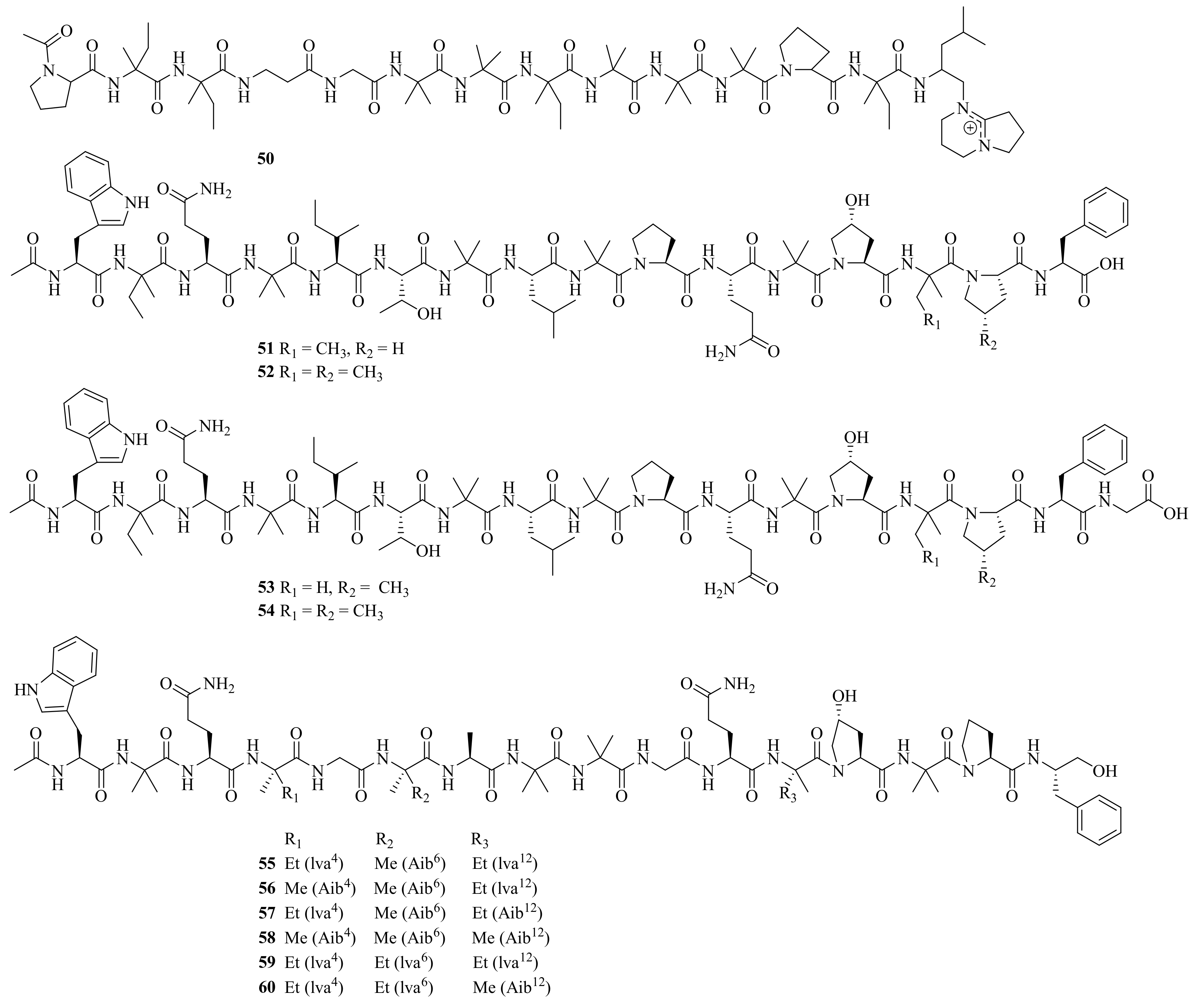
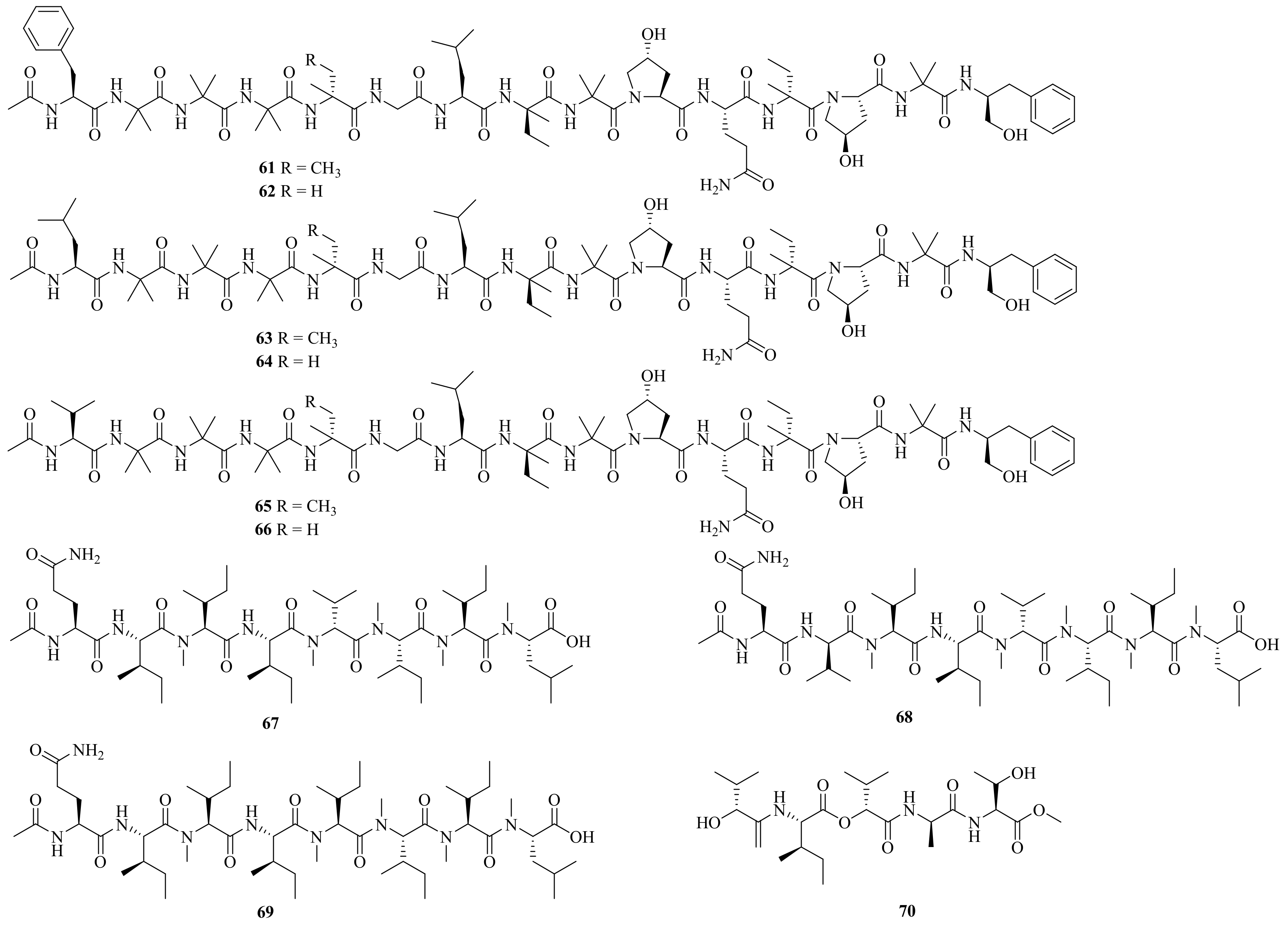


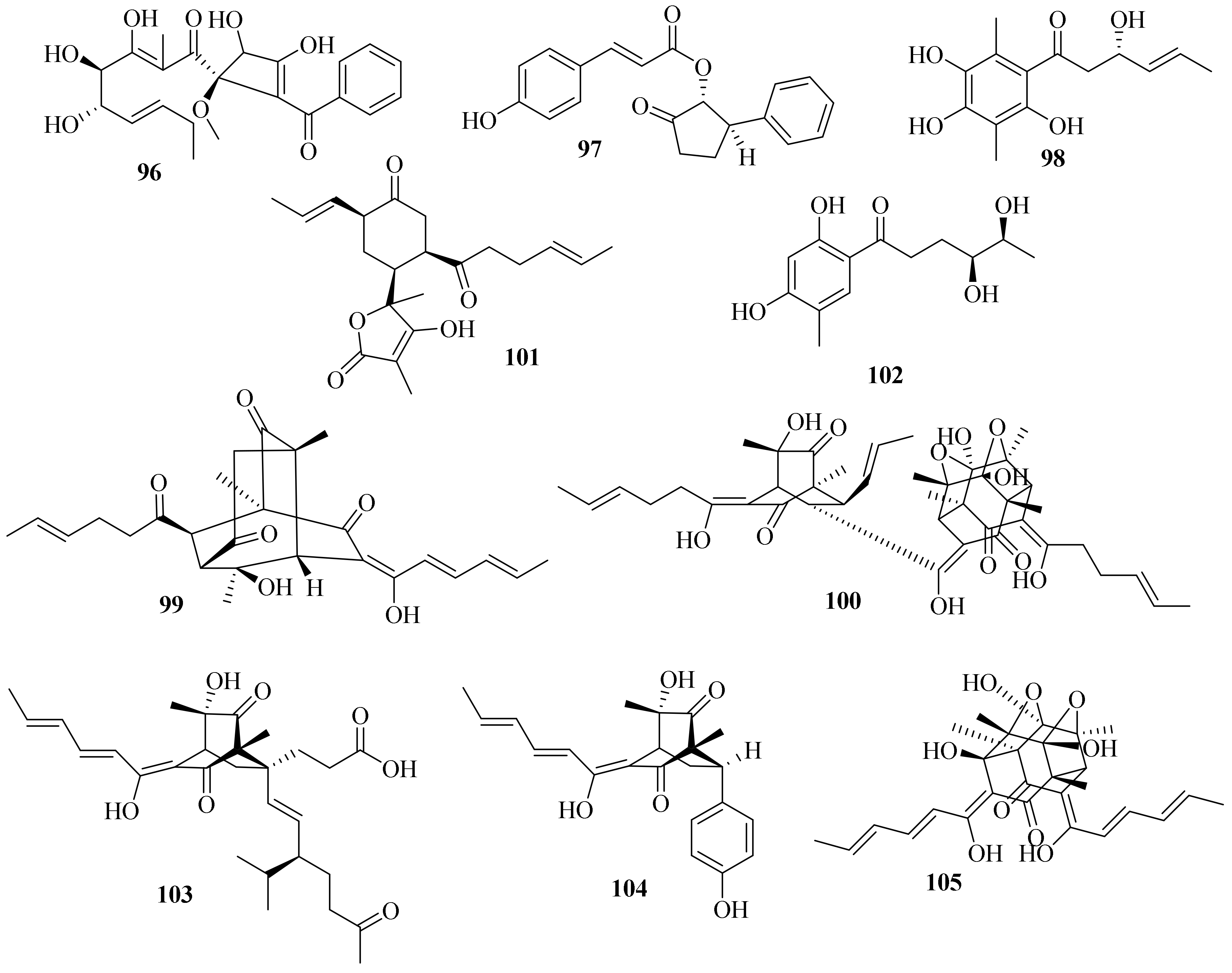
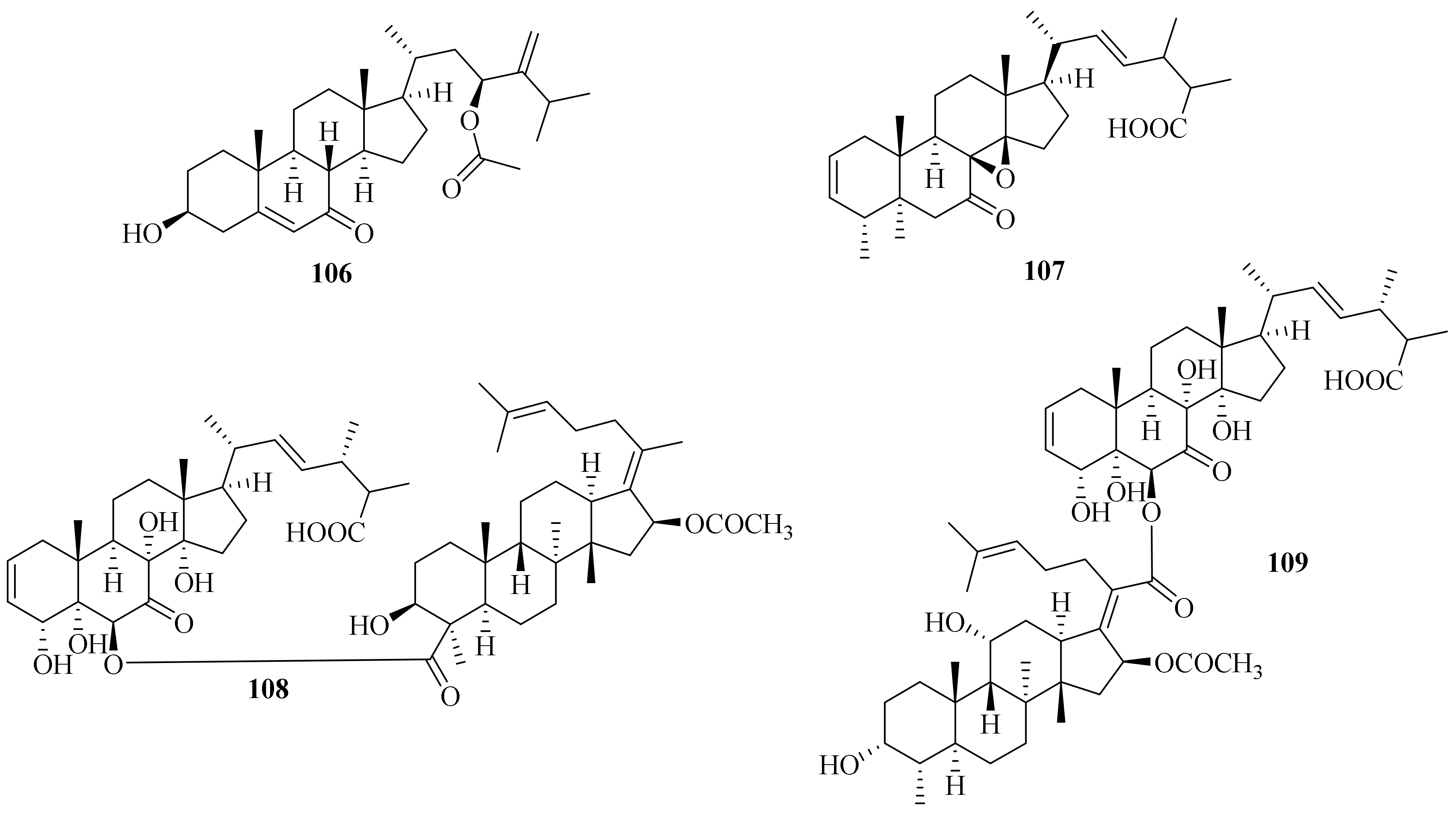


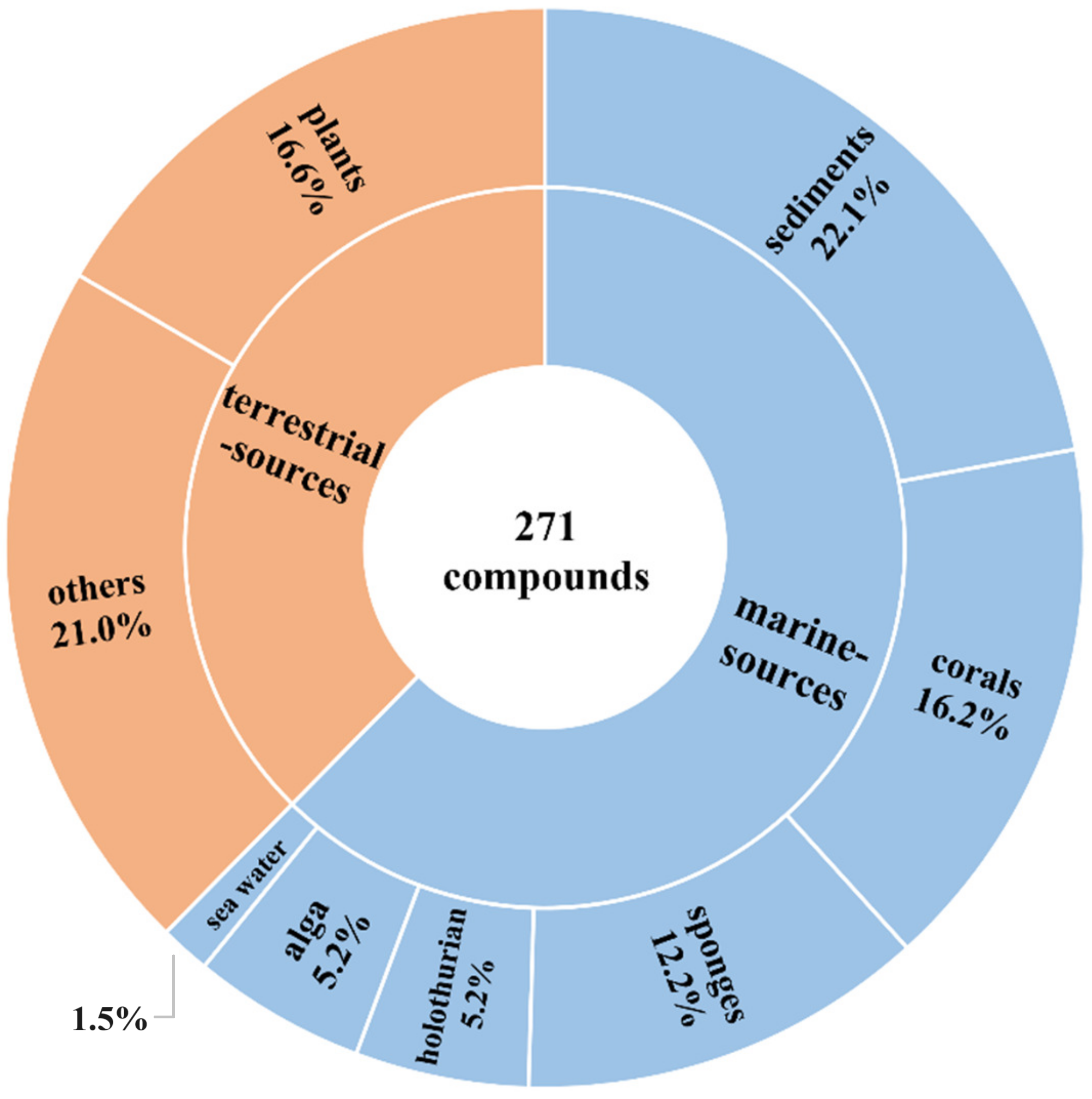
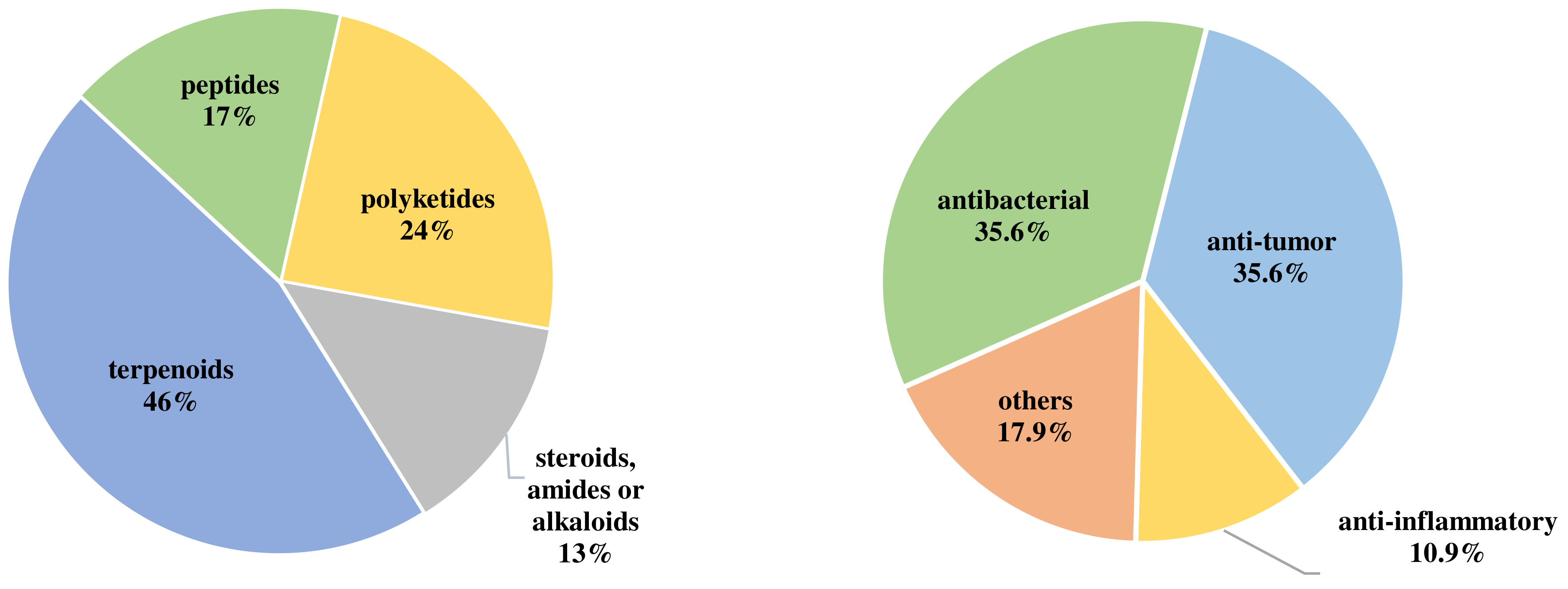
| Compounds | Producing Strains | Sources | Biological Activities | Ref. |
|---|---|---|---|---|
| acremeremophilanes A–O (1–15) | Acremonium sp. TVG-S004-0211 | deep-sea sediments | 2–5, 14: LPS-induced NO production (IC50: 8–45 μM) | [15] |
| marinobazzanan (16) | Acremonium sp. CNQ-049 | marine sediments | anti-tumor | [16] |
| isocordycepoloside A (17) | Acremonium sp. SF-7394 | an unidentified lichen | - | [17] |
| 4-((Z)-but-2-enoyloxy)-12, 13-epoxytrichotheca-7, 9-diene (18) 4-((Z)-but-2-enoyloxy)-12, 13-epoxy-16-hydroxytrichothec-9ene (19) 4-((Z)-but-2-enoyloxy)-8-chloro-12-hydroxy-7, 13epoxytrichothec-9-ene (20) | A. crotocinigenum BCC 20012 | the petiole of the brackish water palm | - | [18] |
| virescenosides Z9–Z18 (21–30) | A. striatisporum KMM 4401 | holothurian | - | [12] |
| acrepseudoterin (31) | Acremonium sp. SF-7394 | an unidentified lichen | PTP1B inhibitor (IC50: 22.8 ± 1.1 μM) | [17] |
| acremochlorins A–M (32–44) | A. sclerotigenum GXIMD 02501 | coral Pocillopora damicornis | 32, 36–38, 42–44: Cytotoxic (MDA-MB-231 and MDA-MB-468) (IC50: 0.48–45 μM) | [10] |
| acremochlorin N (45) 3-phenylcyclopentane-1,2-diol (±-46) | A. furcatum CS-280 | marine sediments | 45–46: anti-Vibrio | [24] |
| acremine S (47) | A. persicinum KUFA 1007 | marine sponge Mycale sp. | butyrylcholine esterase inhibiton | [26] |
| hexahydroacremonintriol (48) | A. masseei CICY026 | plant litter | insecticidal activity (settling inhibition: 48–67%) | [27] |
| acremonidiol A (49) | A. pilosum F47 | the pedicel of the Chinese medicinal plant Mahonia fortunei | - | [28] |
| acremopeptin (50) | Acremonium sp. PF1450 | sediments | - | [29] |
| acremotins A–D (51–54) | A. persicinum SC0105 | sediments | 54: antibacterial (MIC: S. aureus 12.5 μg/mL, MRSA 6.25 μg/mL), anti-tumor (A549, HeLa, HepG2; IC50: 1.2–21.6 μM) | [30] |
| acremopeptaibols A–F (55–60) | Acremonium sp. IMB18-086 | the sponge Haliclona sp. | 55, 59: antibacterial (S. aureus, MRSA, B. subtilis, C. albicans; MIC: 16–64 μM) | [25] |
| emerimicins V–X (61–66) | A. tubakii MT053262 | sediments | 61–62: toxic to zebrafish embryos. 61: antibacterial (MIC: E. faecalis 64 μg/mL, MRSA 32 μg/mL, vancomycin-resistant E. faecium 64 μg/mL) | [31] |
| acrepeptins A–D (67–70) | Acremonium sp. NTU492 | marine alga Mastophora rosea | 67 and 68: LPS-induced NO production (IC50: 12.0 ± 2.3, 10.6 ± 4.0 mM) | [32] |
| acremonpeptides A–D (71–74) | A. persicinum SCSIO 115 | marine sediments | 71 and 72: antiviral activity (HSV-1, EC50: 16, 8.7 μM) | [33] |
| acremonamide (75) | Acremonium sp. strain CNQ-049 | marine sediments | - | [34] |
| Al (III)-acremonpeptide E (76) Acremonpeptide E (77) Fe (III)-acremonpeptide E (78) acremonpeptide F (79) Al (III)-acremonpeptide F (80) Fe (III)-acremonpeptide F (81) aselacin D (82) | A. persicinum F10 | marine sponge Phakellia fusca | antifungal 76 (A. fumigatus MIC: 1 μg/mL) 80 (A. niger MIC: 1 μg/mL) | [35] |
| 2,7-dihydroxy-3,6,9-trimethyl-9H-xanthene-1,4,5,8-tetraone (83) | A. cavaraeanum CA022 | fruiting bodies of Shiraia bambusicola | - | [36] |
| acremine T (84) | A. persicinum KUFA 1007 | marine sponge Mycale sp. | - | [26] |
| acrepyrone A (85) | A. citrinum SS-g13 | the root of the plant Fructus mori | - | [8] |
| triacremoniate (86) | A. citrinum. MMF4 | the root of mangrove plant Kandelia obovata | 86: anti-tumor (HeLa; IC50: 30.46 ± 1.99 μM) | [37] |
| pleoniols A–C (87–89) | Pleosporales sp. F46 and A. pilosum F47 | the pedicel of the medicinal plant Mahonia fortunei | - | [38] |
| 6,8-di-O-methylbipolarin (90) | A. vitellinum MH726097 | the fresh inner tissue of an unidentified marine red alga | 90: insecticidal (H. armigera; LC50: 0.72 mg/mL) | [39] |
| orsaldechlorins A–C (91–93) 5-bromo-2,4-dihydroxy-6-methylbenzoic acid (94) | A. sclerotigenum GXIMD 02501 | coral Pocillopora damicornis | 91–92: inhibit osteoclast differentiation | [40] |
| fusidione (95) | A. fusidioides RZ01 | sea water | 95: anti-tumor (HL-60; IC50: 44.9 μM) | [41] |
| 1-(2′-benzoyl-3,4-dihydroxy- 1′-methoxycyclobut-2′-enyl)-3,4,5-trihydroxy-2-methyl-nona-2,6-dien-1-one (96) | Acremonium sp | the twigs of Garcinia griffithii | - | [42] |
| acrefurcatone A (97) | A. furcatum CS-280 | marine sediments | 97: antibacterial (P. aeruginosa; MIC: 8 μg/mL) | [24] |
| 3(S)-hydroxy-1-(2,4,5-trihydroxy-3,6dimethylphenyl)-hex-4E-en-1-one (98) acremonilactone (99) | Acremonium sp. AN-13 | marine sediments | 98: DPPH free radical scavenging (inhibition rates: 96.50%) | [43] |
| trisorbicillinone E (100) acremosorbicillinoids A and B (101 and 102) | A. citrinum SS-g13 | the root of the terrestrial plant Fructus mori | - | [44] |
| acresorbicillinols A–C (103–105) | A. chrysogenum C10 | unknown | 104–105: antibacterial (S. aureus, C. neoformans; IC50: 86.93 ± 1.72, 69.06 ± 10.50 μM) 105: antioxidant activity (IC50:11.53 ± 1.53–60.29 ± 6.28 μM) | [45] |
| acremocholone (106) | Acremonium sp. NBUF150 | the sponge Ciocalypta sp. | 106: antibacterial (V. scophthalmi, V. shilonii, V. brasiliensis; MIC: 8, 8, 8 μg/mL) | [47] |
| (22E)-25-carboxy-8β,14β-epoxy-4α,5α-dihydroxyergosta-2,22-dien-7-one (107) | A. fusidioides RZ01 | sea water | 107: anti-tumor (HL-60; IC50: 16.6 μM) | [41] |
| acremonidiols B and C (108 and 109) | A. pilosum F47 | the pedicel of the Chinese medicinal plant Mahonia fortune | - | [46] |
| 4R-(1R-Hydroxy-(4-nitrophenyl)-methyl)-1,3-oxazolidin-2-one (110) | A. vitellinum MH726097 | fresh inner tissue of an unidentified marine red alga | 110: insecticidal activity (H. armigera; LC50: 0.56 ± 0.03 mg/mL) | [50] |
| dietziamide C (111) | A. citrinum. MMF4 | the root of mangrove plant Kandelia obovata | - | [37] |
| hypoculoside (112) hypoculine (113) | Acremonium sp. F2434 | sediments | 112: antibacterial (C. albicans, S. aureus, S. cerevisiae; IC50: 11.7, 7.6, 7.2 μM) 113: anti-tumor (LUNG, PAAD; IC50: 9–14 μM) | [51] |
| acremokaloid A (114) 2S,3S-acetyl-β-methyltryptophan (115) | A. citrinum SS-g13 | terrestrial plant Fructus mori | - | [44] |
Disclaimer/Publisher’s Note: The statements, opinions and data contained in all publications are solely those of the individual author(s) and contributor(s) and not of MDPI and/or the editor(s). MDPI and/or the editor(s) disclaim responsibility for any injury to people or property resulting from any ideas, methods, instructions or products referred to in the content. |
© 2024 by the authors. Licensee MDPI, Basel, Switzerland. This article is an open access article distributed under the terms and conditions of the Creative Commons Attribution (CC BY) license (https://creativecommons.org/licenses/by/4.0/).
Share and Cite
Qin, Y.; Lu, H.; Qi, X.; Lin, M.; Gao, C.; Liu, Y.; Luo, X. Recent Advances in Chemistry and Bioactivities of Secondary Metabolites from the Genus Acremonium. J. Fungi 2024, 10, 37. https://doi.org/10.3390/jof10010037
Qin Y, Lu H, Qi X, Lin M, Gao C, Liu Y, Luo X. Recent Advances in Chemistry and Bioactivities of Secondary Metabolites from the Genus Acremonium. Journal of Fungi. 2024; 10(1):37. https://doi.org/10.3390/jof10010037
Chicago/Turabian StyleQin, Yuning, Humu Lu, Xin Qi, Miaoping Lin, Chenghai Gao, Yonghong Liu, and Xiaowei Luo. 2024. "Recent Advances in Chemistry and Bioactivities of Secondary Metabolites from the Genus Acremonium" Journal of Fungi 10, no. 1: 37. https://doi.org/10.3390/jof10010037
APA StyleQin, Y., Lu, H., Qi, X., Lin, M., Gao, C., Liu, Y., & Luo, X. (2024). Recent Advances in Chemistry and Bioactivities of Secondary Metabolites from the Genus Acremonium. Journal of Fungi, 10(1), 37. https://doi.org/10.3390/jof10010037







